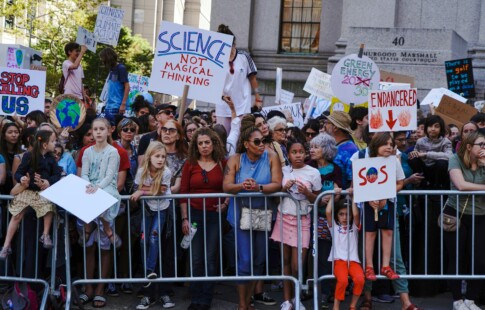
Government Policies on Climate Change
We are reader-supported. When you buy through links on our site, we may earn affiliate commission.
When President Biden took office, he established ambitious climate change prevention goals. Meeting the objectives requires heightened regulations and policies. In hopes of instilling sustainability in America’s infrastructure, he developed the Build Back Better plan. Let’s discover the government policies on climate change and what to expect in the coming years.
The Importance of Climate Change Prevention
Biden’s Build Back Better plan helps both the economy and environment recover, following the COVID-19 pandemic. It allocates two trillion dollars to climate change prevention efforts and clean energy employment. A portion of the funding supports the renewable electricity grid’s development.
Other portions of the funding support technological and systematic advancements. With efficient devices and accessible energy sources, we can effectively shrink our national carbon footprint. Environmental degradation derives from our emissions, fueling the enhanced greenhouse effect.
When solar radiation reaches Earth, it generates heat, warms the surface, reabsorbs excess energy and emits it to space. As greenhouse gases invade the atmosphere, they alter the natural temperature control process. Carbon dioxide has a higher sunlight-to-heat conversion rate and contains heat in the atmosphere for extended periods.
The production and entrapment of solar energy raise the global temperature over time. Fortunately, the government identified pollution emissions as a problem, regulating their uses and preventing other environmental harm.
The Clean Air Act
The Clean Air Act is one of the first notable U.S. government policies on climate change, initiated in 1975. It monitors the air pollution generated by mobile and sanitation sources. Congress established the federal law to protect human health and public welfare.
The transportation sector produces a fifth of all carbon dioxide emissions. Though all states met National Ambient Air Quality Standards, air pollution continues to cause adverse human health effects.
As the climate changes and breathable air quality degrades, humans face serious consequences. Ground-level ozone influences heightened asthma attacks and cardiovascular diseases. Citizens continuously challenge congress, asking for stricter standards within the Clean Air Act, protecting humanity.
The Affordable Clean Energy Rule
In 2009, congress labeled greenhouse gases as a cause of endangerment. The Environmental Protection Agency (EPA) established the Clean Power Plan six years later. The plan regulates fossil fuel-driven power plants, limiting their carbon emissions.
It allows each state to reduce greenhouse gas emissions how they choose. Some utilize carbon offsetting, and others engage in on-site carbon capturing. In 2016, the Trump Administration placed a halt on the plan’s regulations.
When Biden entered office, he brought the policy back under the Affordable Clean Energy rule. The new regulations could reduce greenhouse gas emissions by 1.5% in comparison to 2005 levels. An increase in renewable energy sourcing will limit our reliance on coal and shrink our carbon footprint.
The New Green Deal
Another notable policy is the new green deal. Represented by Alexandria Ocasio-Cortez, the deal converts America’s infrastructural reliance from fossil fuels to clean energy. Its goal is to reduce greenhouse gas emissions and prevent adverse climate change effects.
The deal will additionally heal societal issues, such as racial injustice and economic inequality. Environmental and social problems have remained connected throughout history. Issues like environmental racism affect society every day, degrading natural resources and human health.
Flint, Michigan, experienced a significant environmental injustice in 2014. The low-income region contains the General Motors vehicle manufacturing center. Corporations were dumping production waste in the local river, supplying the city’s drinking water.
The waste generated high bacterial levels, causing legionnaire disease. Consuming the drinking water killed 12 residents and left others ill. Government officials kept citizens in the dark throughout the outbreak.
This case of environmental racism pushed congress to re-evaluate the new green deal. With strict regulations and management, we can hold corporations accountable for their actions and place human health before capitalistic endeavors.
The Paris Agreement
President Biden also signed the Paris Agreement during his first day in office. The international treaty is legally binding and affects our national regulations. In 2015, 196 regions signed the agreement at the United Nations Framework Convention on Climate Change (UNFCCC).
The Paris Agreement aims to reduce the global temperature by two degrees Celsius, contrasting pre-industrial levels. In achieving the ambitious objective, we must accept current emission rates as the peak. From there, we may implement renewable energy sources and emission reduction requirements, helping us achieve carbon neutrality.
The Build Back Better policy in part derived from the Paris Agreement. Though the treaty is not synonymous with a national policy, it influences our government, commercial and residential actions positively. America is the second-largest carbon dioxide polluter, emitting 5.41 billion metric tons annually.
Our reliance on fossil fuel-driven transportation and resource exploitation significantly contribute to climate change. We may reduce our impact by taking personal environmental conservation measures and implementing strict regulations and policies.
The Biden Administration
Over the past four years, we viewed an absence of ecological concern or acknowledgment. As Biden continues his presidency, we can expect our climate change prevention measures to change. He has already implemented government policies on climate change, regulations and changes, reducing greenhouse gas emissions, and we can expect further policy development over the next four years.
Share on
Like what you read? Join other Environment.co readers!
Get the latest updates on our planet by subscribing to the Environment.co newsletter!
About the author
Jane Marsh
Starting from an early age, Jane Marsh loved all animals and became a budding environmentalist. Now, Jane works as the Editor-in-Chief of Environment.co where she covers topics related to climate policy, renewable energy, the food industry, and more.





